What Is AI Diversity & How Can It Help Build Inclusive Workplaces
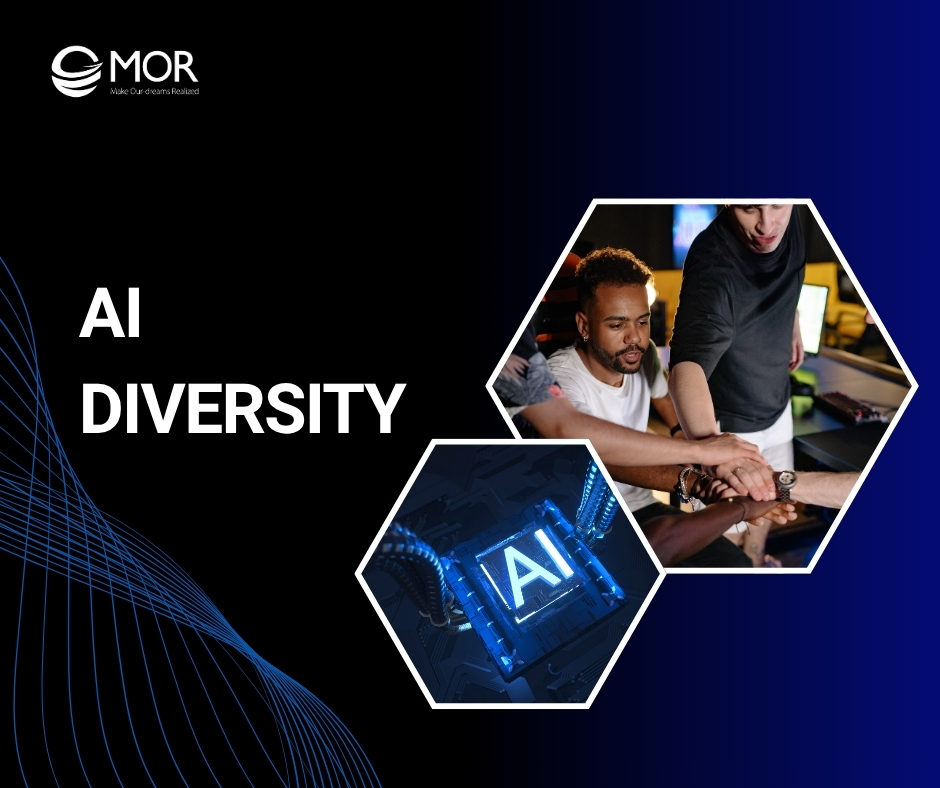
Many businesses say they care about diversity, but few know how to turn words into action. That’s where AI diversity makes a real difference. It helps companies move from good intentions to measurable progress on inclusion. This MOR Software’s guide will show you how AI and diversity tools can support fair hiring, smarter training, and a stronger workplace culture, step by step.
What Is AI Diversity?
AI diversity refers to how artificial intelligence tools are designed and used to support inclusion across the workplace. These tools make it easier for companies to build fairer systems, especially in areas like hiring, internal training, and flexible work policies.
The goal is to apply technology in a way that supports real diversity efforts, not just surface-level changes.
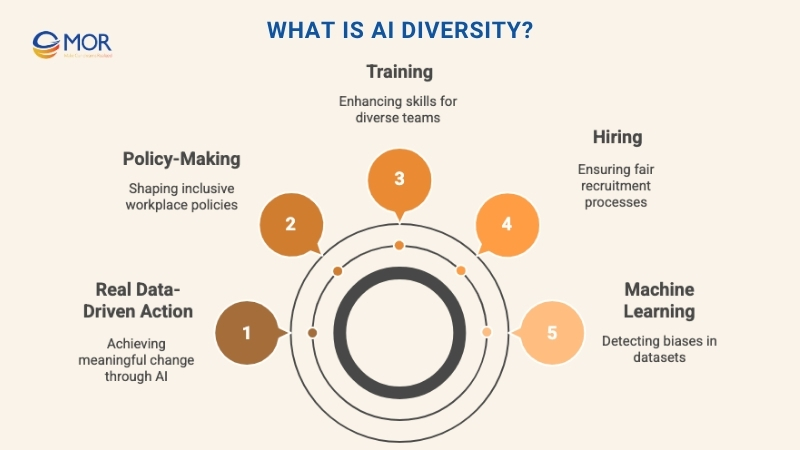
At the core of AI and diversity tools are machine learning model. These systems take in large amounts of historical data, pick out trends, and predict outcomes based on that information.
Over time, they get smarter, recognizing subtle patterns like bias in recruitment data or performance evaluations. That’s how businesses start shifting from intention to action when it comes to inclusion.
From identifying blind spots to improving decision-making, artificial intelligence diversity is not just about using tech. It’s about using it right.
Why Is AI Diversity Important?
AI diversity matters because it brings two things together, technology and fairness. When businesses use AI automation with inclusion in mind, they can make smarter choices without reinforcing old biases.
Creating a more inclusive workplace isn’t just a nice-to-have. It drives real results. A report found that 68% of companies with strong employee engagement have a clear DEI plan. On top of that, 57% of HR professionals say DEI-focused efforts improve company performance and compliance.
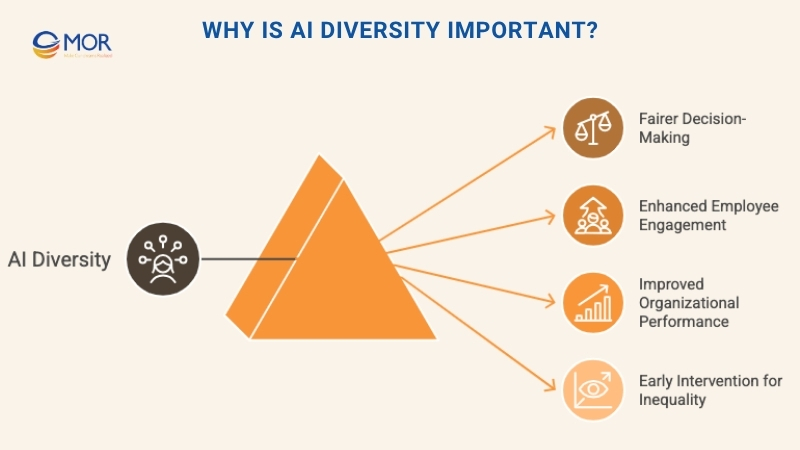
By using diversity in AI, organizations can scale their DEI strategies with more precision. These tools can process years of past data to uncover hidden patterns, like biased hiring trends or unequal access to development opportunities. Fixing those early means stronger teams and fewer long-term problems.
Practical Ways AI Diversity Enhances DEI Outcomes
AI diversity has the potential to make workplaces fairer by transforming how companies recruit, hire, and train their people. Instead of relying on outdated systems filled with unconscious bias, businesses can use AI to make more balanced, data-backed decisions.
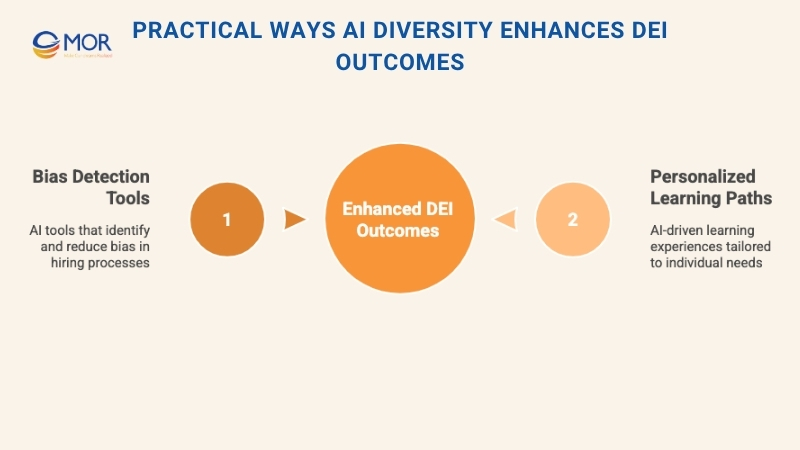
Let’s take a closer look at how this works.
Smarter Hiring With Built-In Bias Detection
Bias in hiring isn’t new, and it shows up in the numbers. In the U.S., Black and Hispanic workers still face higher unemployment rates, 5.6% and 5%, compared to 3.4% for White and Asian individuals. That gap has persisted, in part, because traditional hiring systems aren’t built to be fair.
Now, AI is helping change that. Tools like Textio scan job descriptions and interview prompts to flag biased language before it reaches candidates. Instead of vague suggestions, it gives clear feedback so teams can write more inclusive, thoughtful content.
Enterprise AI platforms like TalentLyft go further by removing identifying information during screening. That means candidates are reviewed based on skills, not assumptions. The platform’s AI and diversity features also allow HR teams to plug in extra modules, like skill-based assessments or personality tests, to build a full, fairer picture of each applicant.
Personalized Growth Paths Through AI
AI diversity isn’t just about hiring. It also changes how people grow inside a company. With the right tools, businesses can tailor learning paths that match how employees think, work, and improve.
AI-powered platforms track behavior and performance over time. Then they suggest the right training, whether it’s a new skill, a refresher, or a full course. This makes learning feel relevant, not random.
One example is Disco, a social learning tool powered by AI. It helps teams build and manage cohort-based training, skill upgrades, and learning communities. The format is flexible, so people can learn in ways that suit them best, whether that’s in a group, one-on-one, or self-paced.
That’s how AI helps shape more inclusive development, addressing different aspects of AI in employee experience.
What Are the Potential Risks In AI Diversity Adoption?
AI diversity can help companies move forward, but it’s not risk-free. Like any tool, it depends on how it’s built and how it’s used. Problems often start with flawed data or unclear processes, and that can put DEI efforts in reverse.
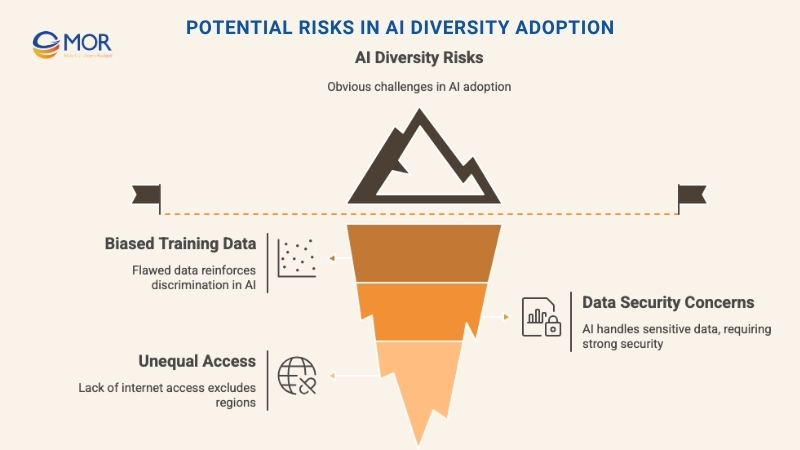
Below we’ll highlight a few common challenges.
Bad Data Means Bad Outcomes
AI tools are only as good as the data they’re trained on. If that data is biased, outdated, or unbalanced, the tool will likely repeat the same issues businesses are trying to fix. A well-known example was META’s image generator, which struggled to accurately depict interracial couples, because it learned from biased image sets.
In workplace tools, this can go much deeper. If training data excludes or misrepresents certain groups, it can reinforce stereotypes and skew hiring or development decisions. That’s the opposite of what AI diversity statement efforts aim to achieve. And without careful oversight, it’s easy to miss these flaws until damage is done.
Data Safety Is Non-Negotiable
For AI automation tools to work well, they need access to internal systems, like employee profiles, feedback forms, and training records. That means handling large amounts of sensitive data. Without strong protections, that data becomes a liability.
If controls are weak, coworkers could see information they shouldn’t. Worse, outside attackers could trick employees into giving up credentials using tactics like phishing or fake profiles. Once they’re in, the damage goes far beyond just lost data, it erodes trust and puts your DEI goals at risk.
Unequal Access To AI Technology
Even with the rise of free AI tools, not everyone gets to use them. In many developing regions, access to internet, mobile devices, or updated computers is still limited. According to the World Bank, just 67% of the world’s population is online. That gap affects who can learn, who can contribute, and who gets left behind.
This matters because AI diversity only works when it includes everyone. If only a portion of employees or regions can access these tools, your DEI strategy may unintentionally leave others out. It’s a reminder that diversity in AI also means checking who has access to the technology itself.
How To Align AI Tools With Your AI Diversity Strategy?
Understanding the value and risks of AI diversity is just the first step. The real progress comes when you start using these tools with purpose. That means making thoughtful decisions about what you want to achieve, how you’ll track progress, and who will be involved.
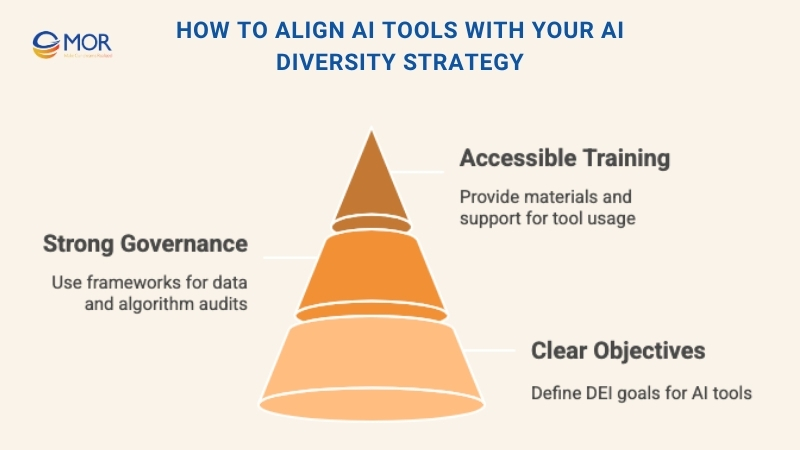
Set Clear Objectives Before You Begin
Start by defining your priorities. Are you trying to reduce hiring bias? Improve learning access? Or strengthen workplace inclusion? Pinpoint the results you want from your AI diversity tools before adding any new technology to your stack.
This kind of clarity makes rollout easier and avoids wasted resources. Many companies choose to partner with trusted AI automation agencies that specialize in artificial intelligence diversity applications. With the right support, your AI implementation is more likely to fit your actual business goals, not just check a box.
Build Guardrails With Strong Governance
Using AI diversity tools without clear rules can backfire. That’s why every organization needs an AI governance framework. This should cover how data is collected, stored, and deleted, especially when sensitive employee information is involved.
Regular algorithm audits are a must. These help catch bias early, before it shapes hiring, promotion, or training outcomes. Governance isn’t about slowing things down, it’s about keeping your DEI strategy fair and consistent over time.
Make Sure Everyone Can Use The Tools
To get real value from AI diversity tools, everyone in your team needs to know how to use them. That means giving employees the right training and support, not just access. Each person should feel confident using the features built into your DEI tools.
Start with the basics. Create training docs, walkthrough videos, and step-by-step tutorials. Ask for feedback as people go through the process. Track how teams are engaging with the training, step in when someone needs extra help, and update your learning materials as needed.
Also, help your team connect the dots between these tools and your DEI goals. When people understand why the tools matter, and how they support fairness, they’re more likely to use them consistently. That’s when AI and diversity efforts stop being theory and start showing up in daily work.
Embrace AI Diversity With MOR Software
AI diversity is more than a trend, it’s a practical way to build fairer, smarter workplaces. Whether you're starting from scratch or refining your DEI strategy, the right AI automation services can make a measurable difference. They help spot bias early, reduce risks tied to compliance, and create consistent, inclusive experiences across your organization.
That’s where MOR Software comes in.
As one of Vietnam’s top it outsourcing companies in Vietnam, we specialize in building custom AI solutions tailored to real business needs.
Our team takes time to understand your goals, review your existing systems, and recommend an approach that fits, not just technically, but ethically. We develop AI tools that align with your business values and support inclusive hiring, learning, and decision-making.
Working with MOR means you get more than software. You get a partner. Our engineers build reliable systems that adapt to your workflows, meet data privacy standards, and support your DEI roadmap. From smart screening tools to learning platforms that reflect diverse growth paths, we design AI that works for people.
Let’s build better workplaces together. Reach out to MOR Software to explore how AI can support your DEI goals and help your team thrive. Contact us to get started.
Conclusion
Building a more inclusive workplace takes more than good intentions. It takes the right tools and strategy. AI diversity gives you the ability to find bias, fix it, and create better outcomes for everyone. At MOR Software, we understand how to turn AI into a force for equity. From custom development to system integration, our solutions are built to fit your business and support your DEI goals. Ready to take the next step? Contact us today and let’s bring your AI diversity vision to life.
MOR SOFTWARE
Frequently Asked Questions (FAQs)
What is diversity in AI?
Diversity in AI refers to using artificial intelligence tools to support a more inclusive and fair workplace. It includes removing hiring bias, enabling equal learning access, and ensuring algorithms don’t reinforce stereotypes.
How is AI used in diversity and inclusion?
Companies use AI to screen job descriptions, anonymize candidate data, and recommend personalized development plans. These tools help HR teams make more fair and data-backed decisions that support DEI efforts.
What is an example of AI discrimination?
A known case is facial recognition software performing poorly on people with darker skin tones due to biased training data. These examples show how flawed inputs can lead to unfair outcomes, highlighting the need for responsible AI use.
Why is AI so feared?
Many people fear AI because of how quickly it evolves and how little control they feel over its decisions. Concerns range from job loss to ethical misuse and bias, especially in high-stakes areas like hiring and criminal justice.
Can AI actually reduce bias in hiring?
Yes. When trained correctly, AI can help identify biased language in job descriptions, anonymize applicant details, and score candidates based on skills rather than personal background. This makes hiring more objective and inclusive.
Rate this article
0
over 5.0 based on 0 reviews
Your rating on this news:
Name
*Email
*Write your comment
*Send your comment
1